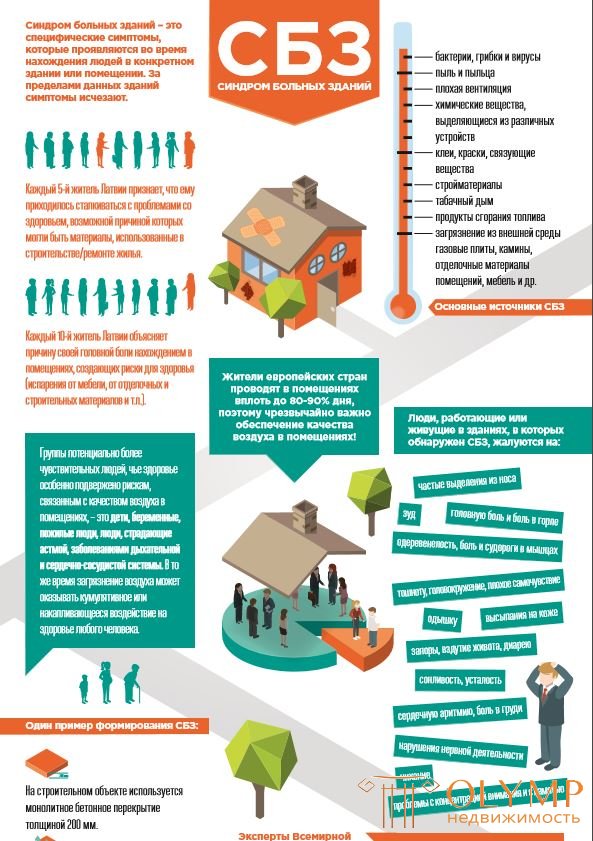
Have you started to notice that things happen unpleasantly at home with you?
For example, headache, paroxysmal sneezing, nausea throat. The cause of this condition is impossible to understand.
The first thing that comes to mind is poisoning and everyone is starting to remember what they ate at work. Many people associate their well-being with fatigue. But in reality, the environment in which a person lives is to blame for these ailments. his apartment.
Scientists around the world are constantly working on the creation of environmental technologies - eco-homes, eco-transport, eco-furniture, etc. The future is green applications and high technology. But until this future has come, people suffering from the "sick buildings syndrome" complain of fatigue, frequent colds, sore throat, they itch their nose or eyes, feel dizzy and have a headache. Such symptoms affect residents of new buildings or renovated buildings. The root cause of a person’s poor health is an environmentally dirty apartment. |

Hygienists, such diseases as tuberculosis, rheumatism, cardiovascular and mental diseases are referred to as diseases of housing origin. |
Paint, which cover the wallpaper for painting, doors, window sills are dangerous because of the volatile solvents they contain.
If possible, get rid of polymer wallpaper, synthetic carpets and bedspreads in rooms where you spend a lot of time.
Pay attention when buying paint on the annotation to them. They can only be for exterior work or for interior work. There are paints produced on the basis of latex and emitting mercury vapor into the atmosphere or containing lead. They are used only for exterior decoration.
According to scientists, one of the main causes of "sick building syndrome" lies in the presence of mold fungi in the living room. What is important is the so-called microbial seeding of air, i.e. the number of microorganisms per unit volume of air. When their number exceeds the allowable rate, the person begins to hurt. Mold fungi (spores, mycelium fragments - mycelium), in addition to the infectious and toxic effects on the human body, can provoke the development of allergic reactions. Spores of fungi can occur indoors when entering with atmospheric air, with clothing and shoes worn on a person.
Mushrooms can use the most diverse and unexpected substrates as breeding ground: tile, wood, oil and water-based paint, wallpaper, plaster, whitewash, cement; develop on furniture, walls, ceiling, window frames, heating pipes, clothes, shoes.
Mushrooms actively colonize food. But most often the mold fungus is parasitic in the bathrooms.
The growth and development of fungal mold is directly dependent on the level of humidity and ventilation indoors. To get rid of mold in the bathroom, it is necessary to eliminate the causes that led to an increase in humidity and, as a result, the appearance of colonies of fungi.
Such reasons include: accidents of water supply and ventilation, chronic “leakage” of old plumbing, violation of waterproofing, “disease” of old tile. It is equally important to remove the existing mold. To combat mold fungi, the use of special preparations, fungicides, is crucial. And the use of special building materials in bathrooms that prevent fungi, in principle, can make mold growth impossible.
Basic ideas about the effects of mold fungi allergens on the human body were laid back in the 20s of the last century, when Dr. Storm van Lewin at Leiden University studied the influence of "climate allergens" - mold fungi and bacteria - on the development of asthma. Recently, there was evidence that mold fungi, affecting a person, enhance the specific immune response to other allergens (tick-borne or dust) in sensitive people. Doctors, hygienists and environmentalists see them as the cause of many diseases. The international name for "sick building syndrome" is Sick Building Syndrome.
Causes of Sick Building Syndrome
Causes and factors contributing to the development of the sick building syndrome:
1. Poor (insufficient) ventilation of the room.
2. Chemical pollution from domestic sources.
3. Chemical pollution from external sources:
4. Biological pollution
Building inspection process
The purpose of the building survey is to identify and eliminate the causes of poor indoor air quality, prevent their recurrence and avoid other problems.
To achieve this goal, researchers need to: establish whether health complaints are related to the quality of the internal air; discover the cause; identify appropriate corrective actions. Air quality research is the process of gathering information, forming a hypothesis and testing it. As a rule, the analysis begins with a step-by-step inspection of the problem area. It is necessary to collect information on four main factors that affect indoor air quality: people living (or staying) in a building; heating, ventilation and air conditioning; possible ways of penetration of pollutants; possible sources of pollutants. Preparation for the inspection should include: search for available information about the building history and the causes of poor air quality; clarification of the location of heating, ventilation and air conditioning systems; informing the residents (or staying) in the building of people about the upcoming survey; identification of persons with access to detailed information. The inspection itself includes bypassing the critical areas of the building and interviewing residents (office workers).
Что бы оставить комментарий войдите
Комментарии (0)